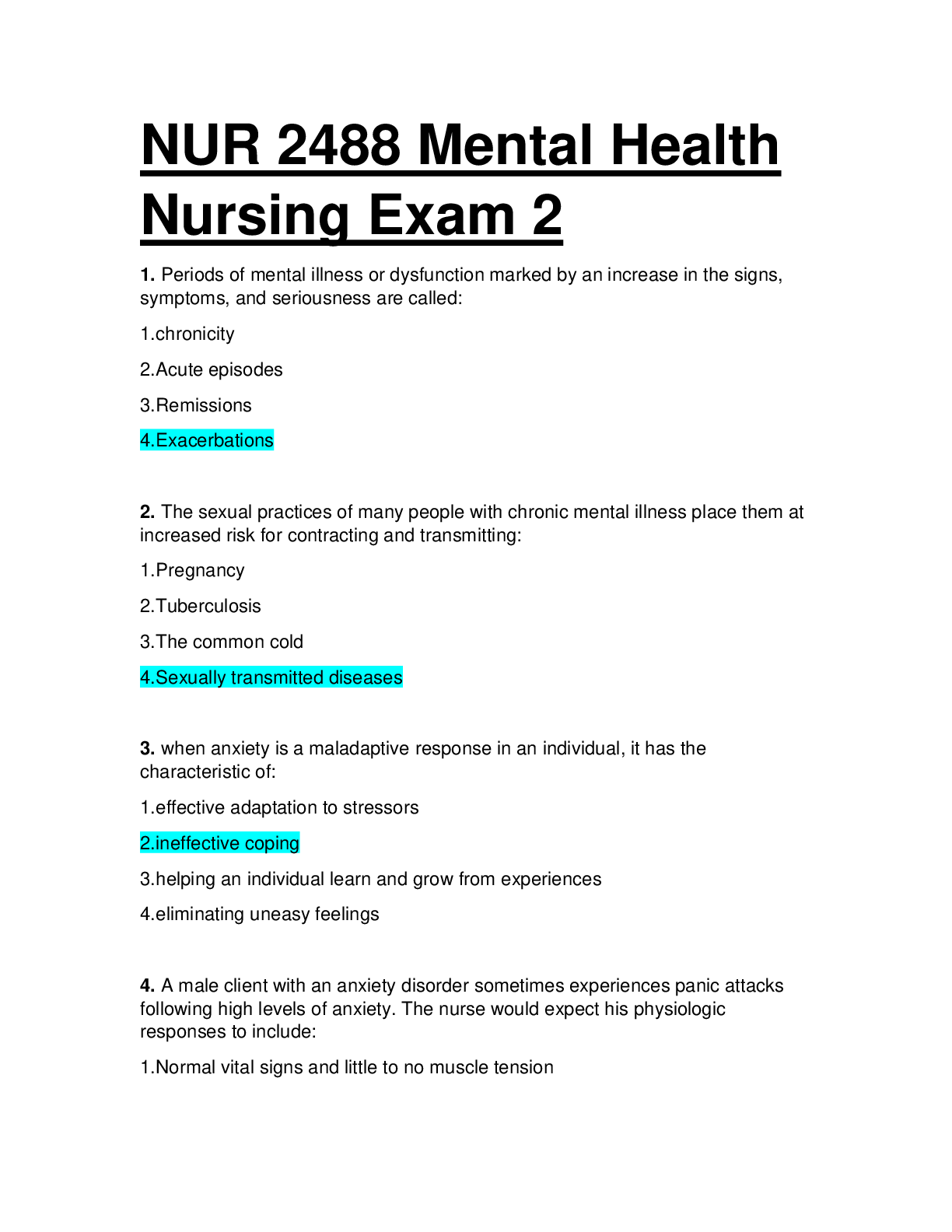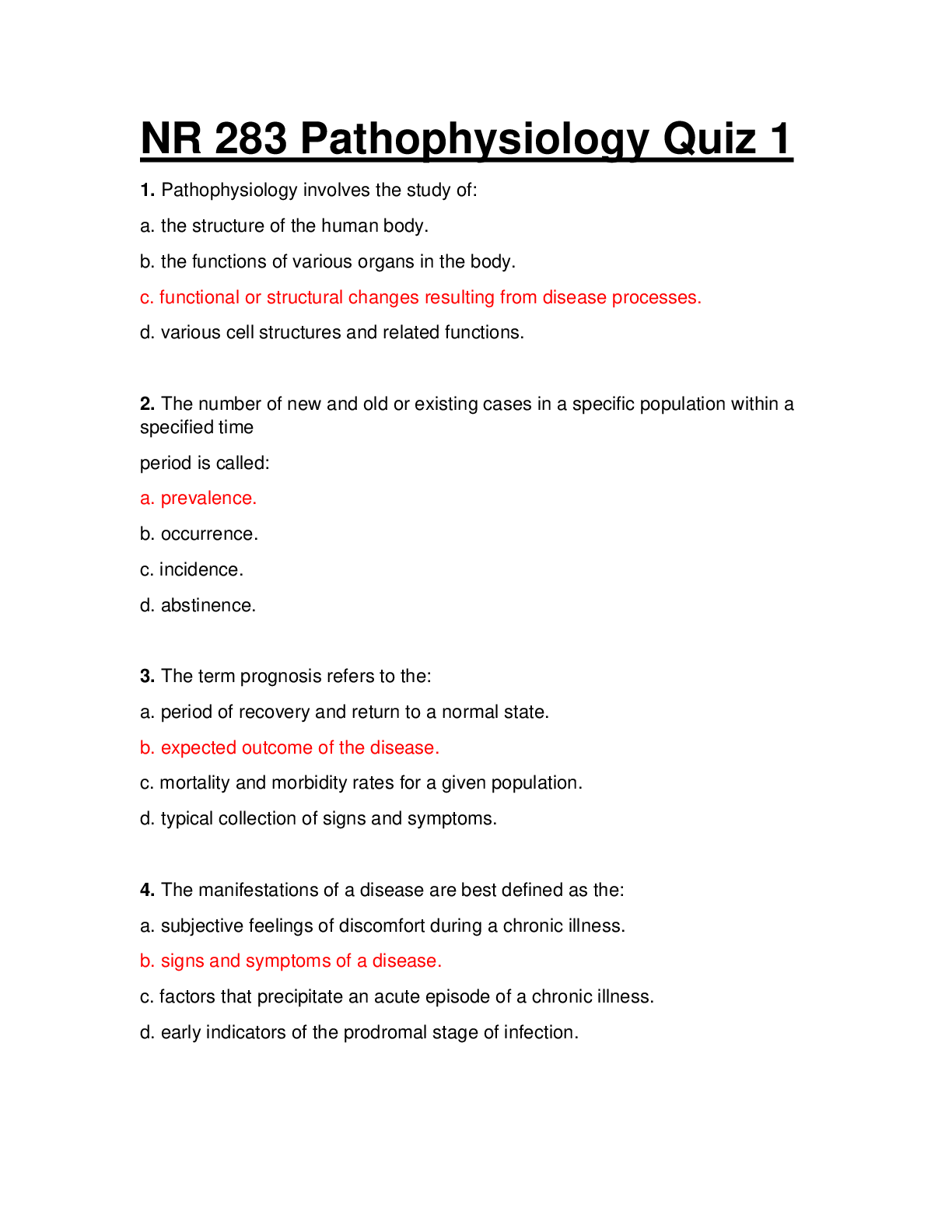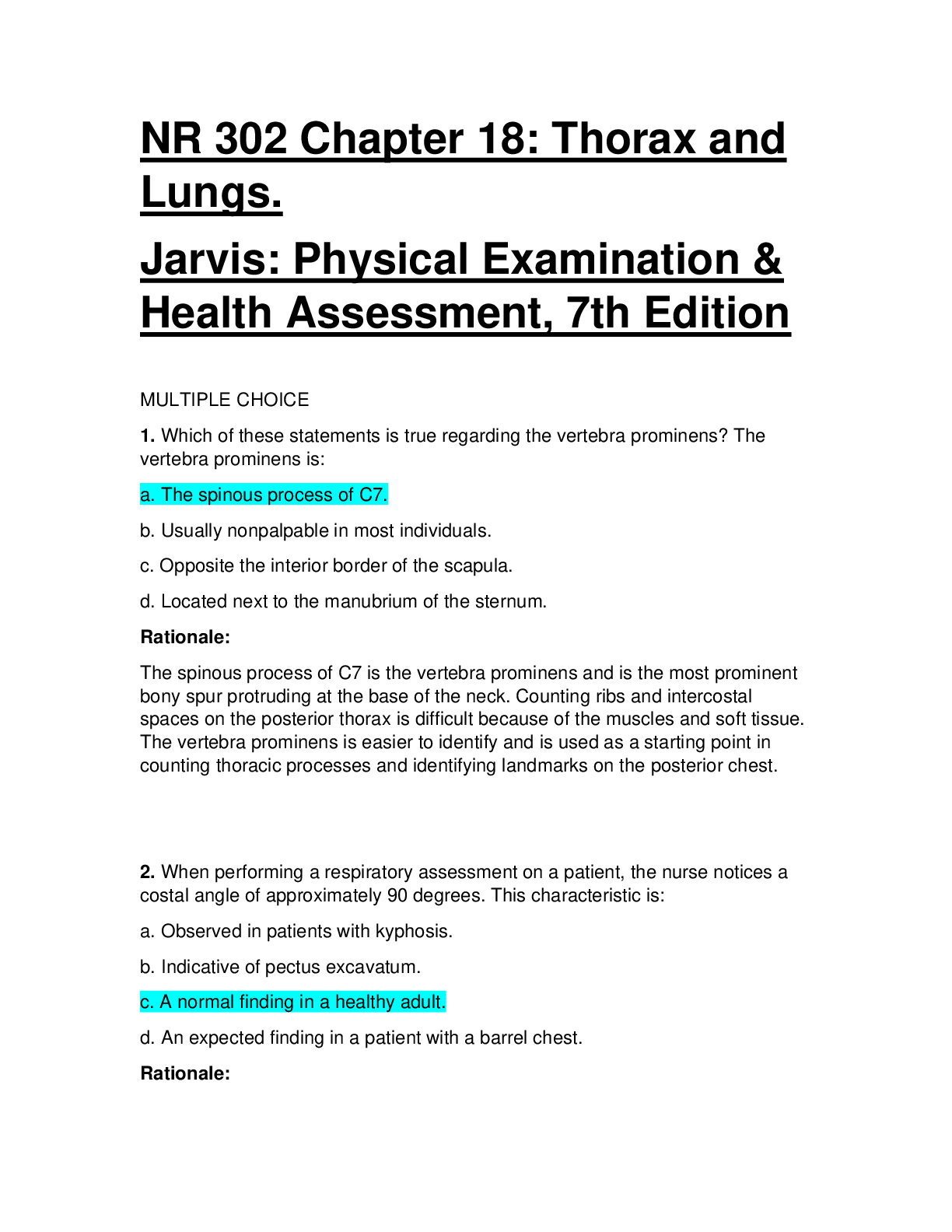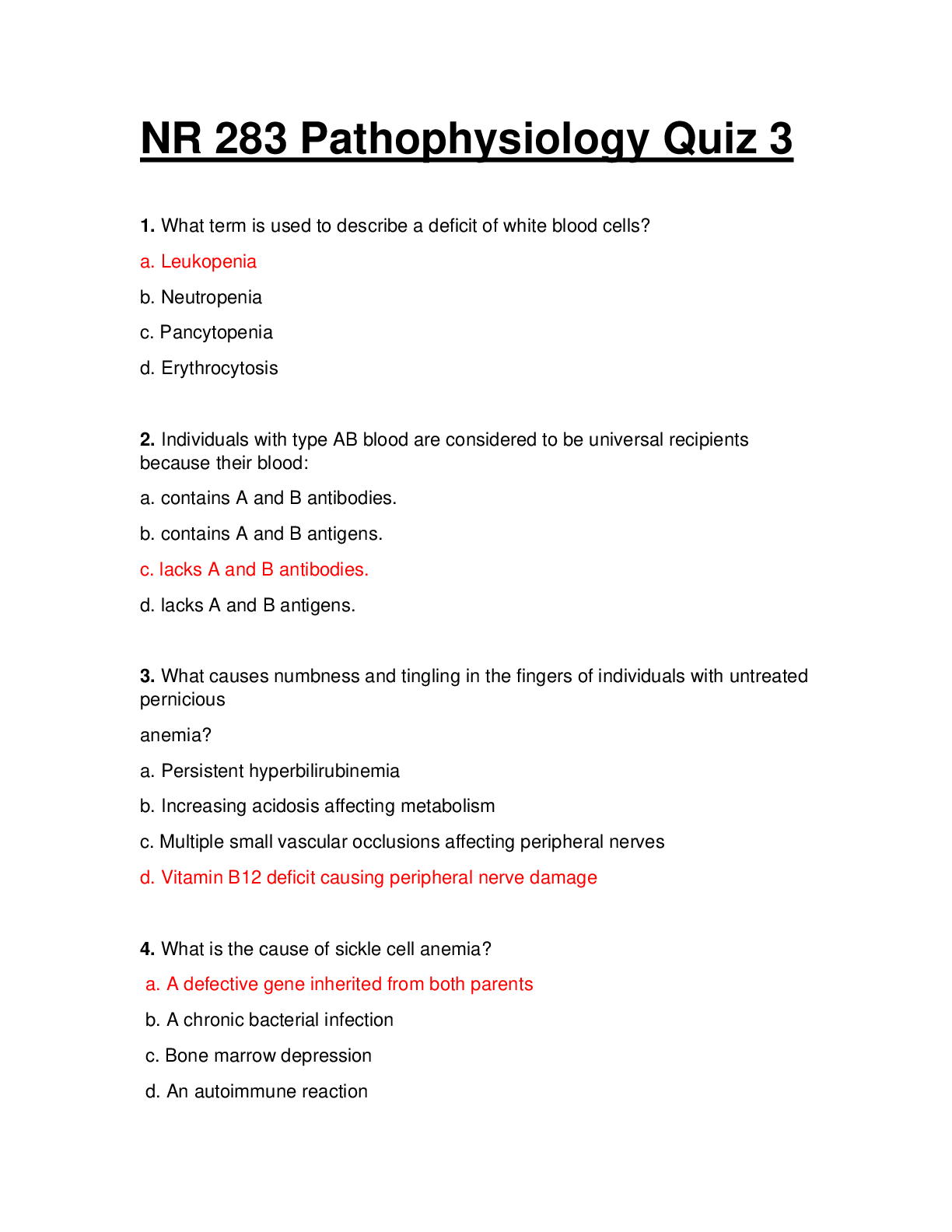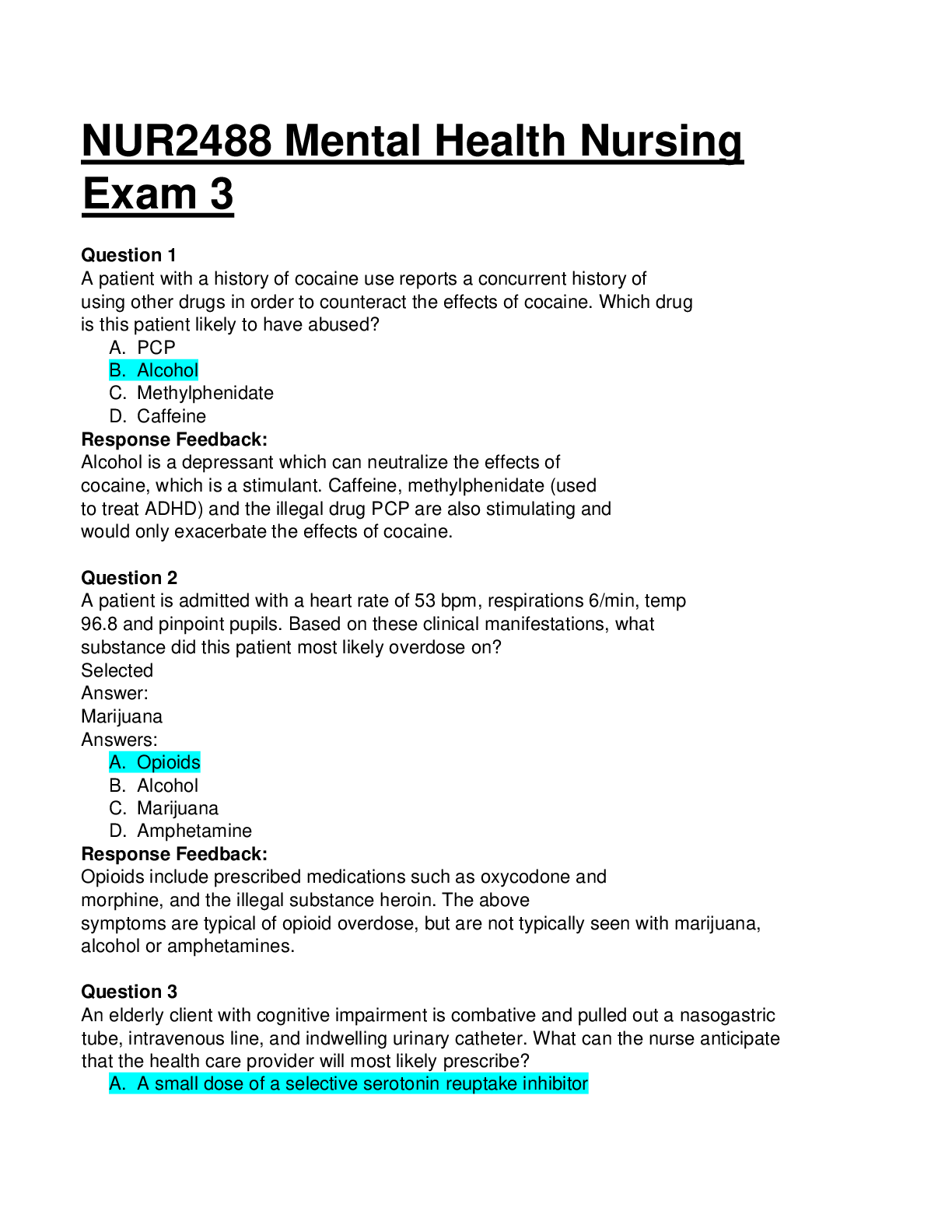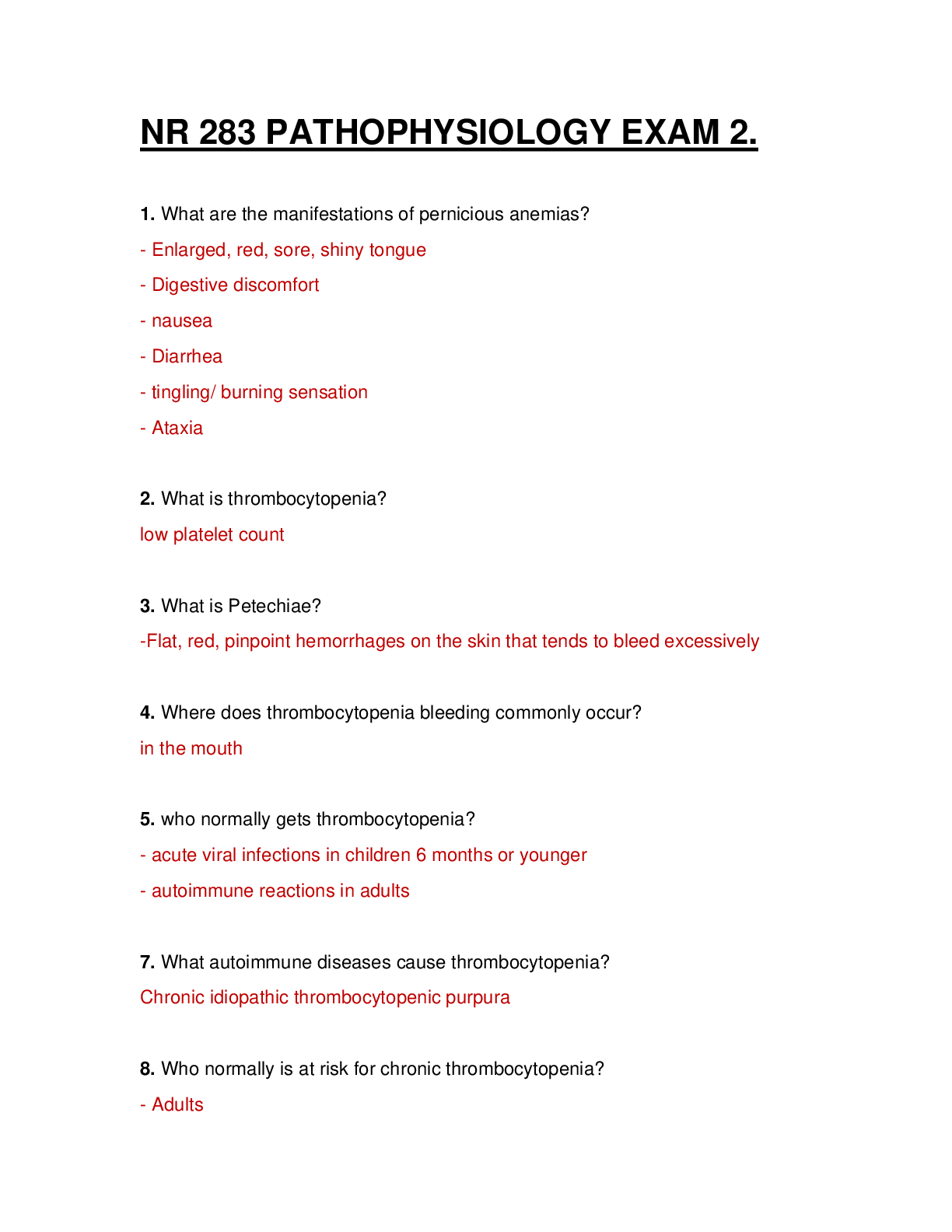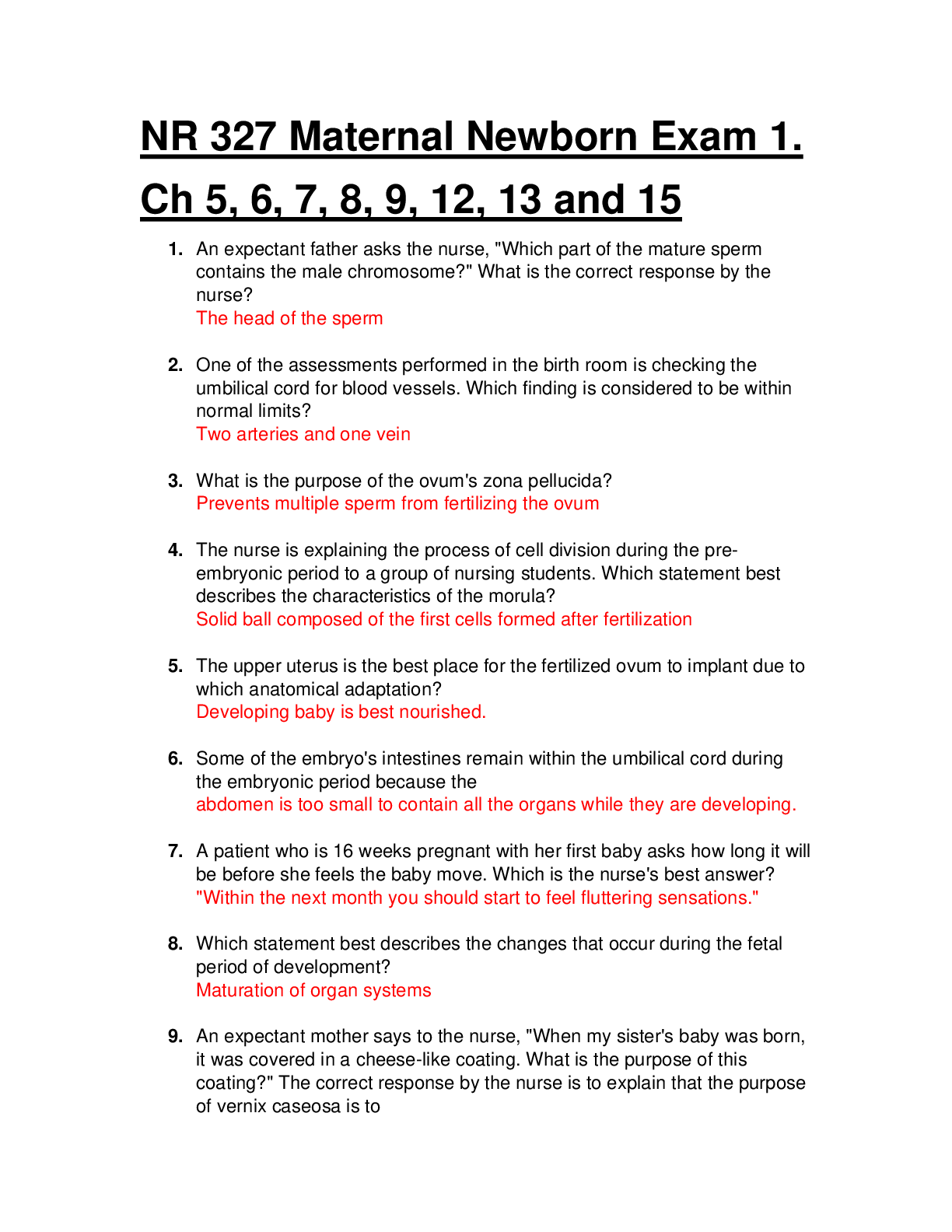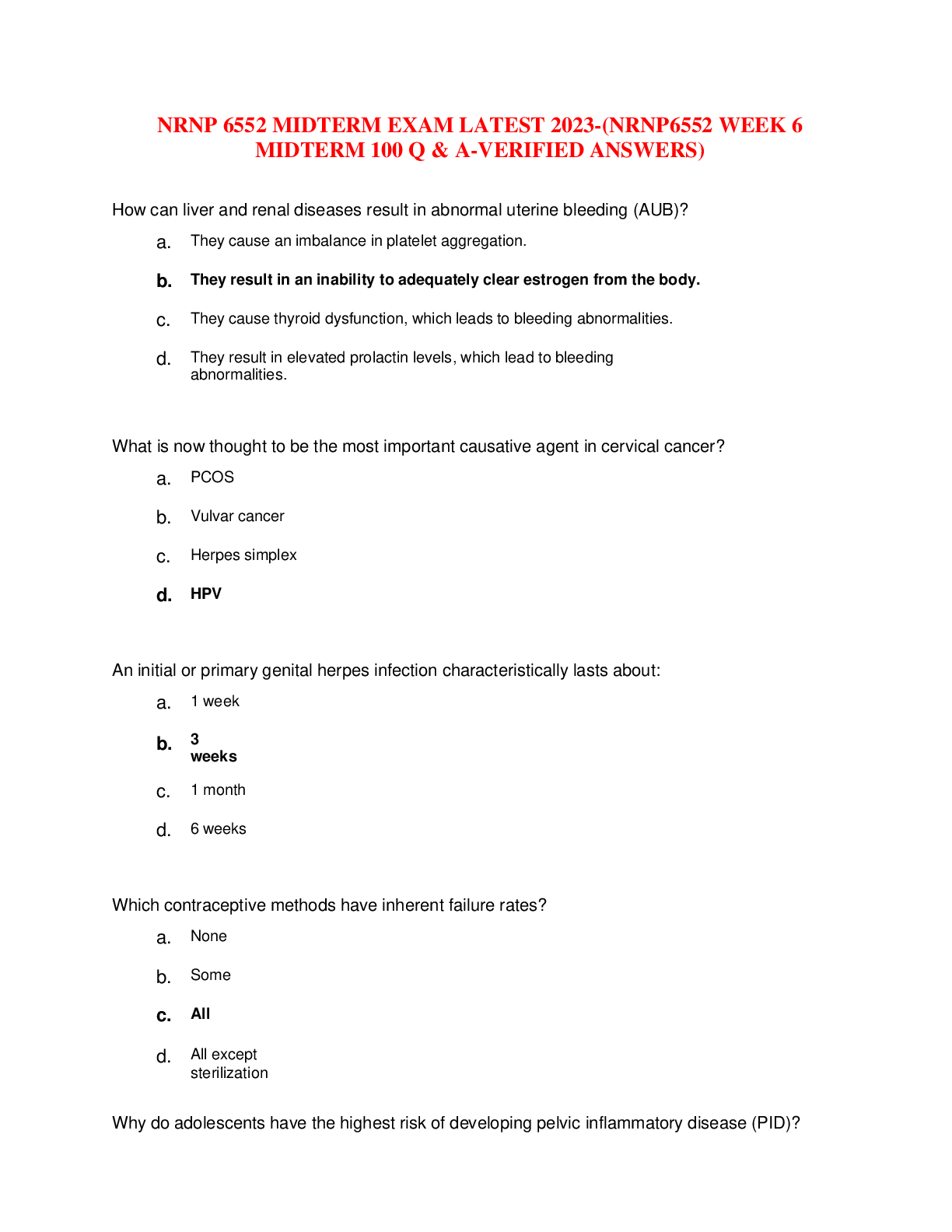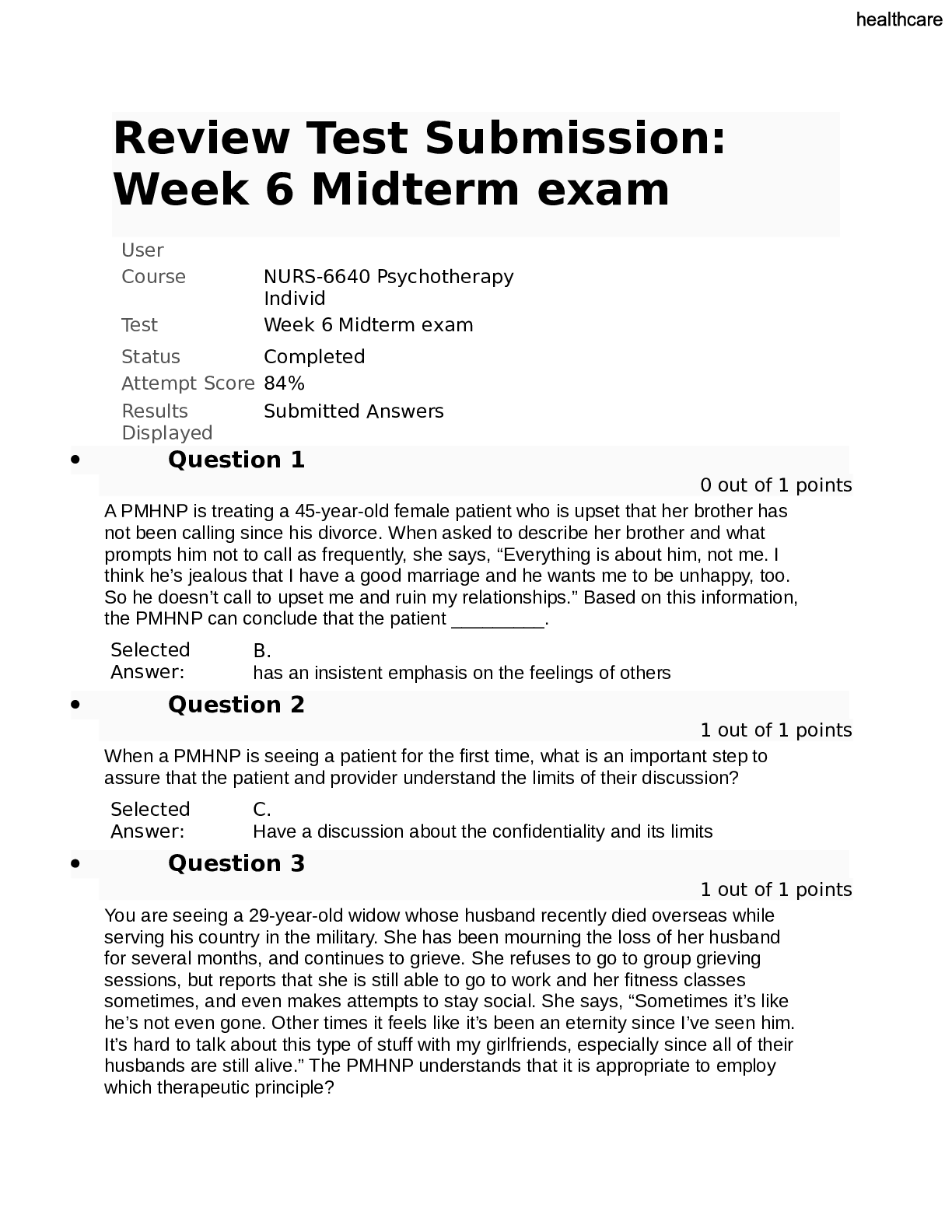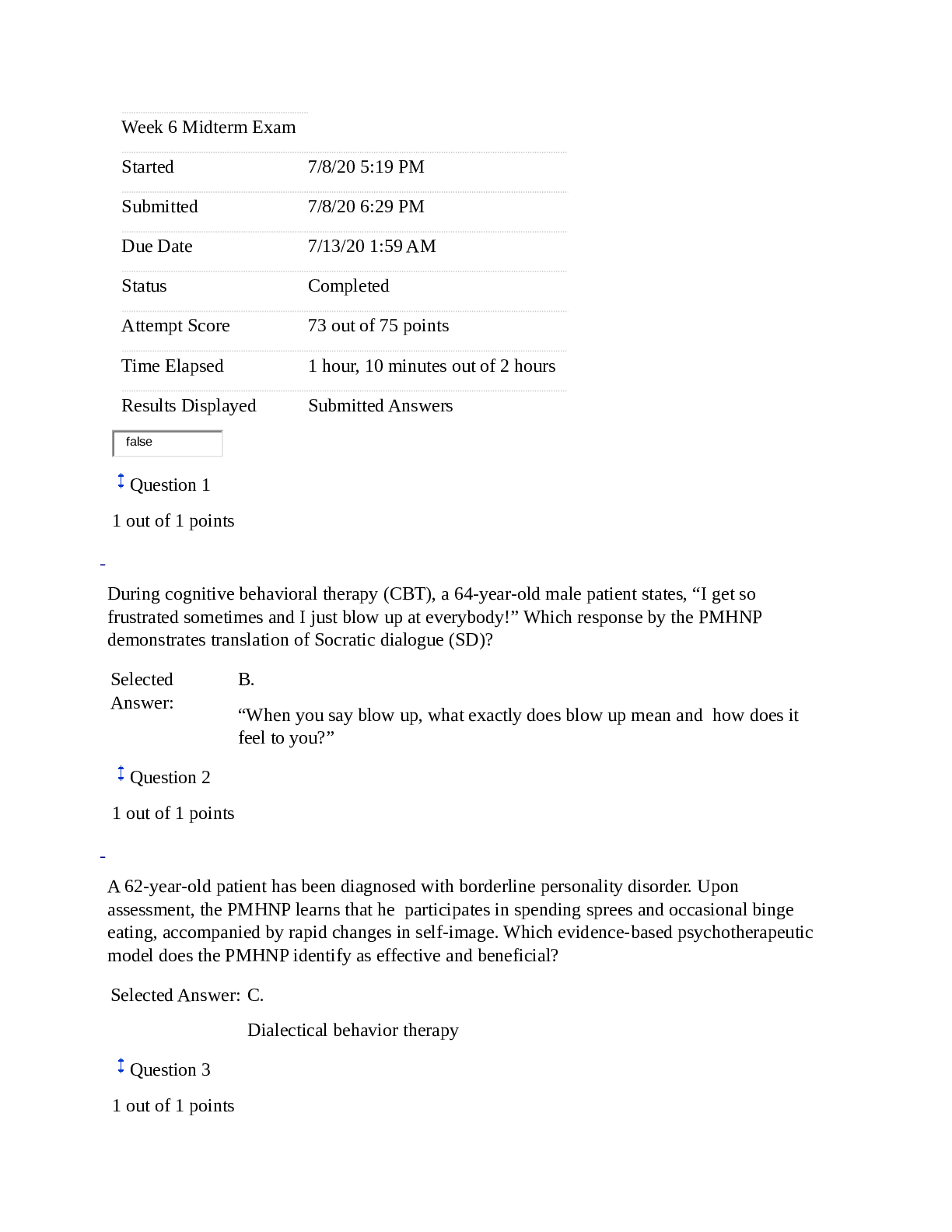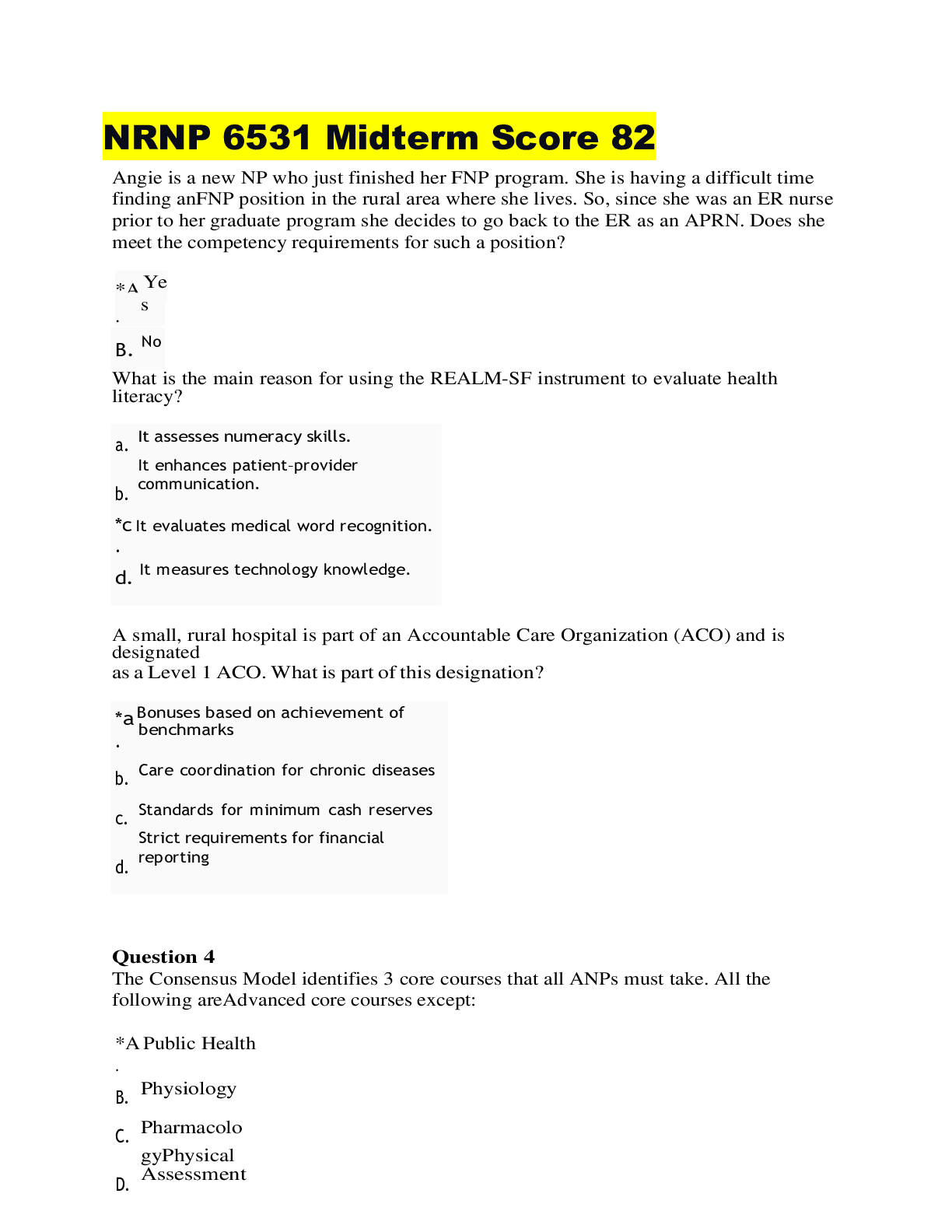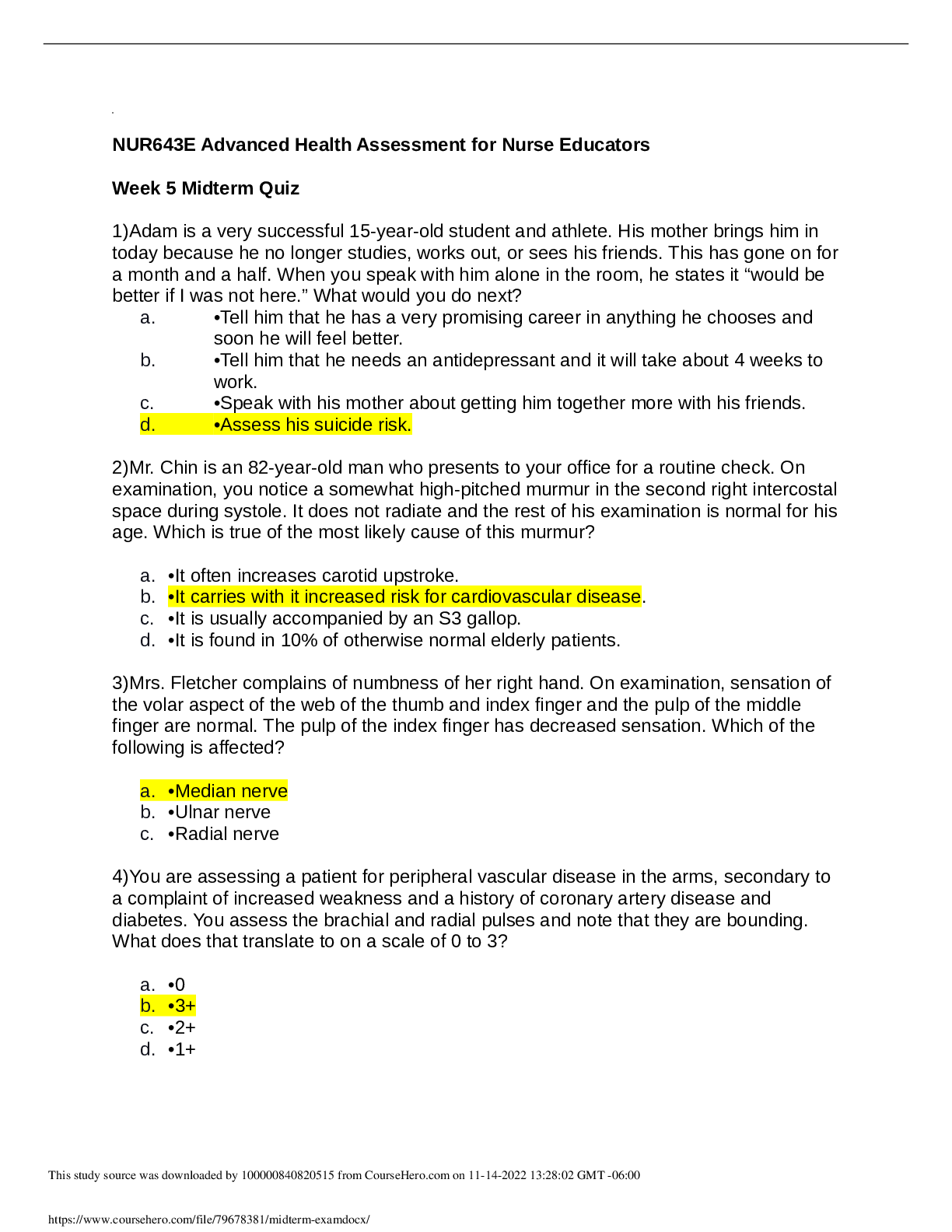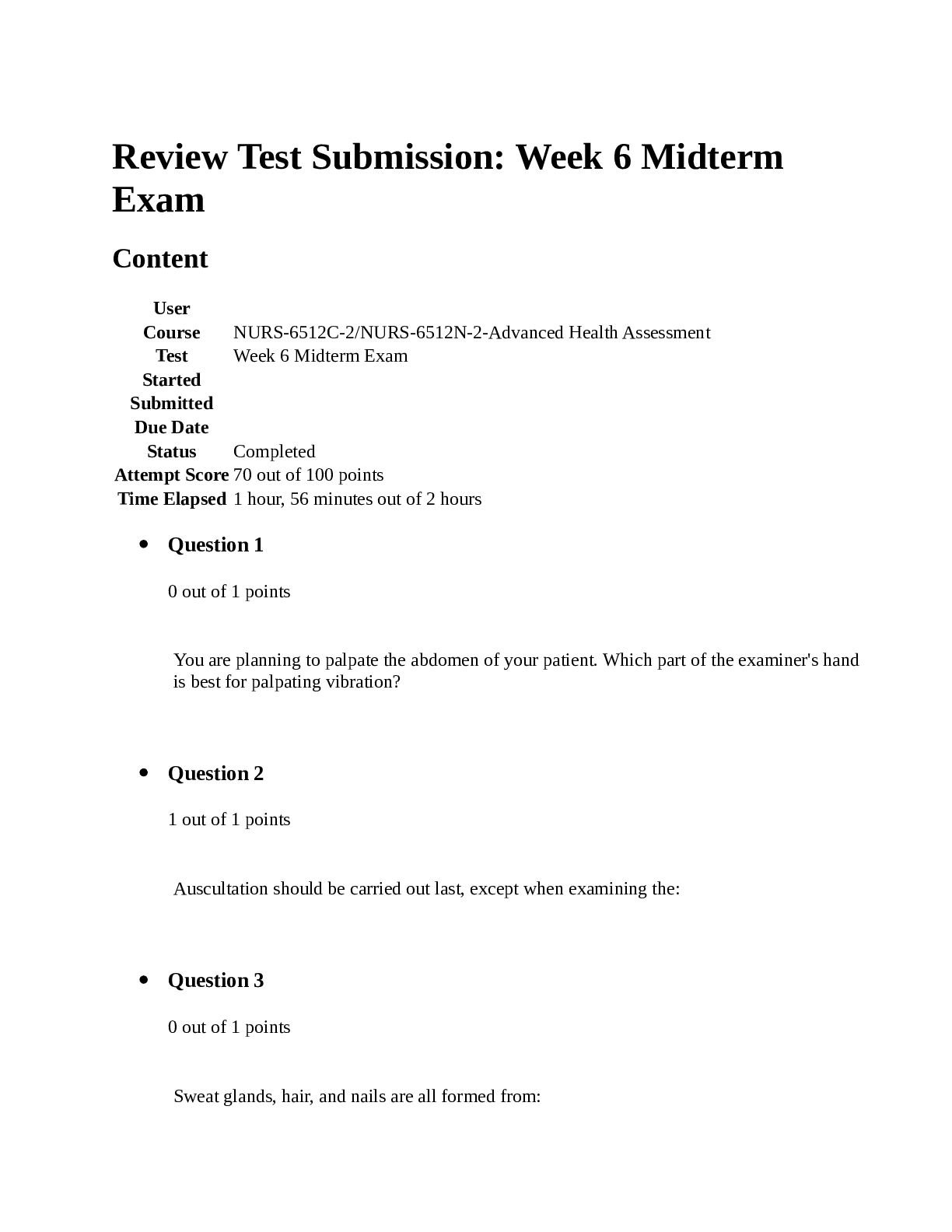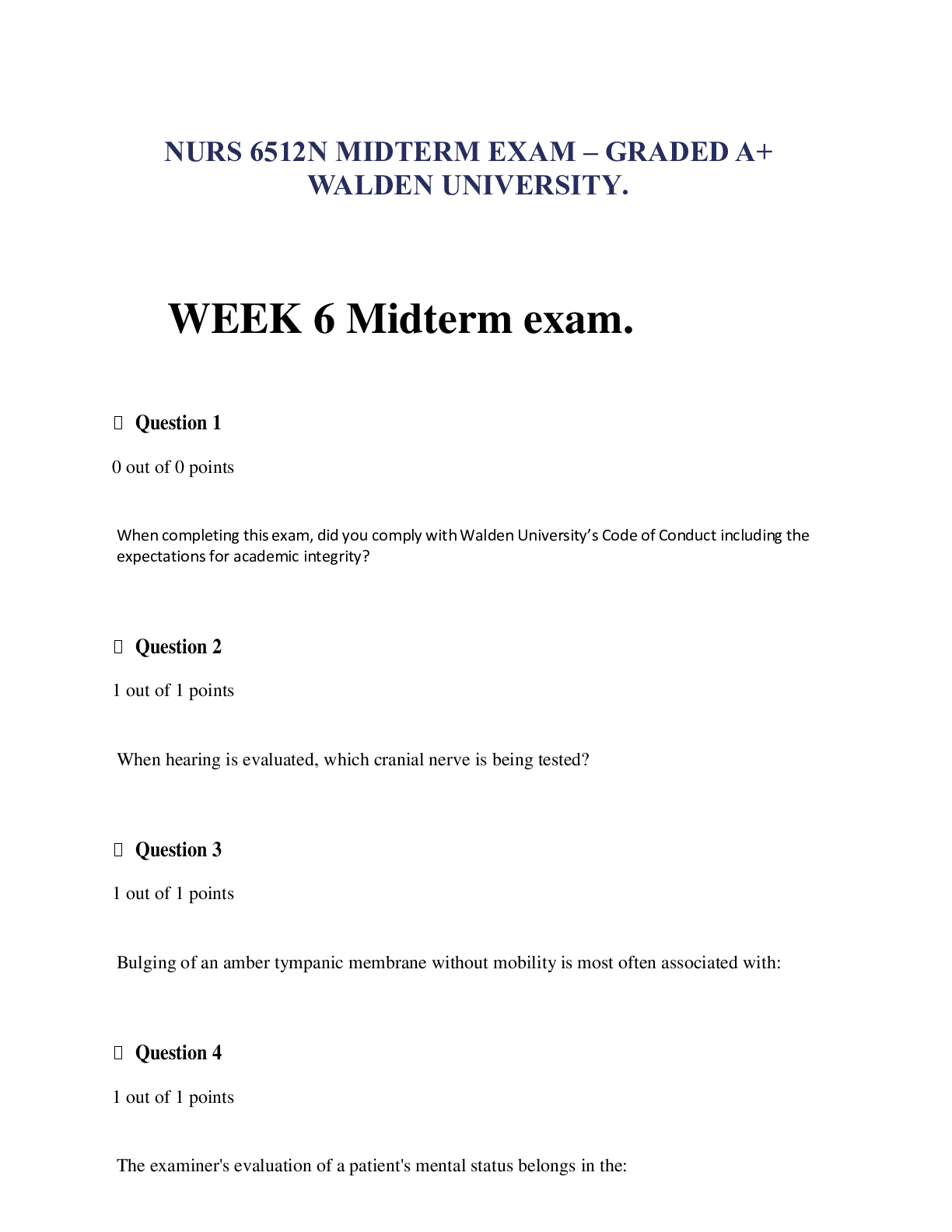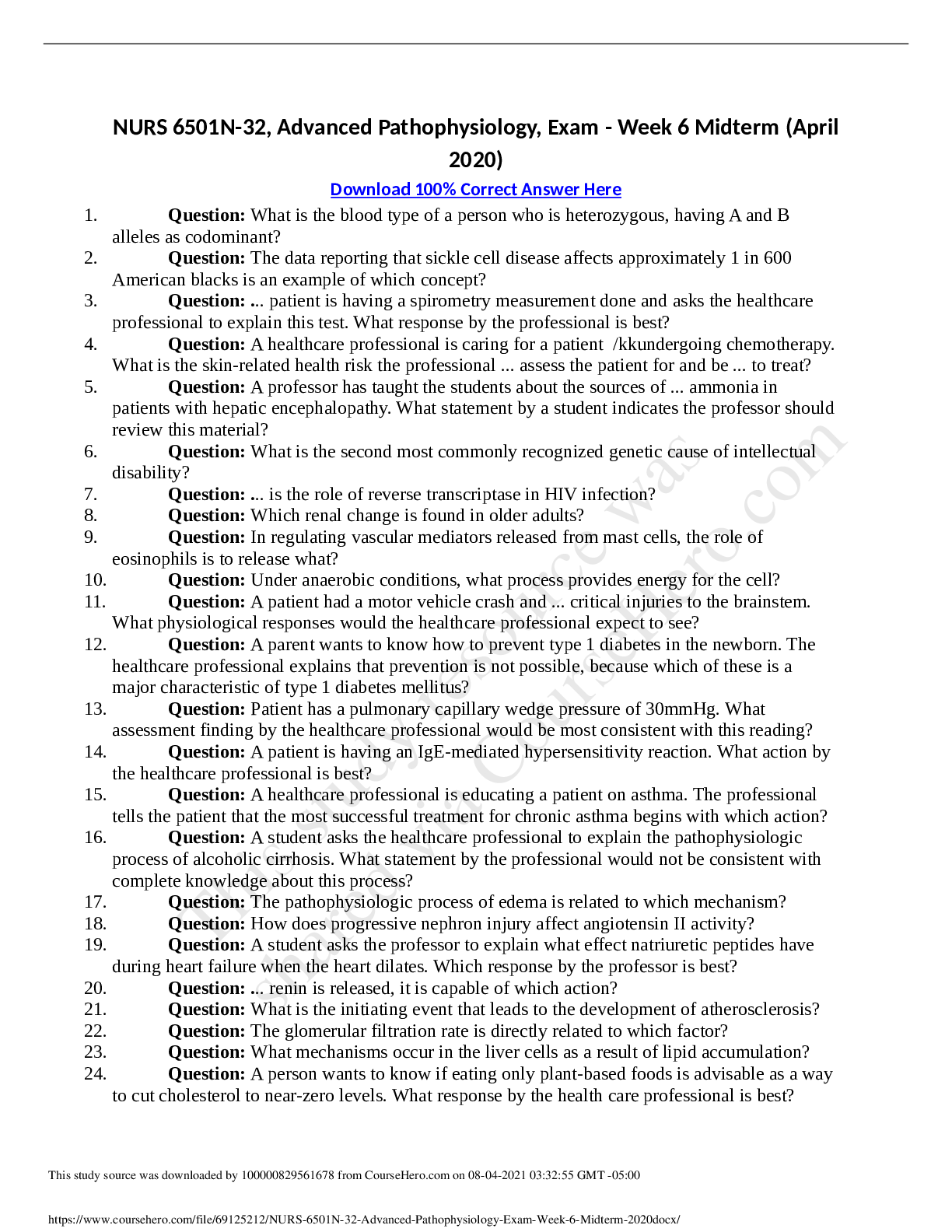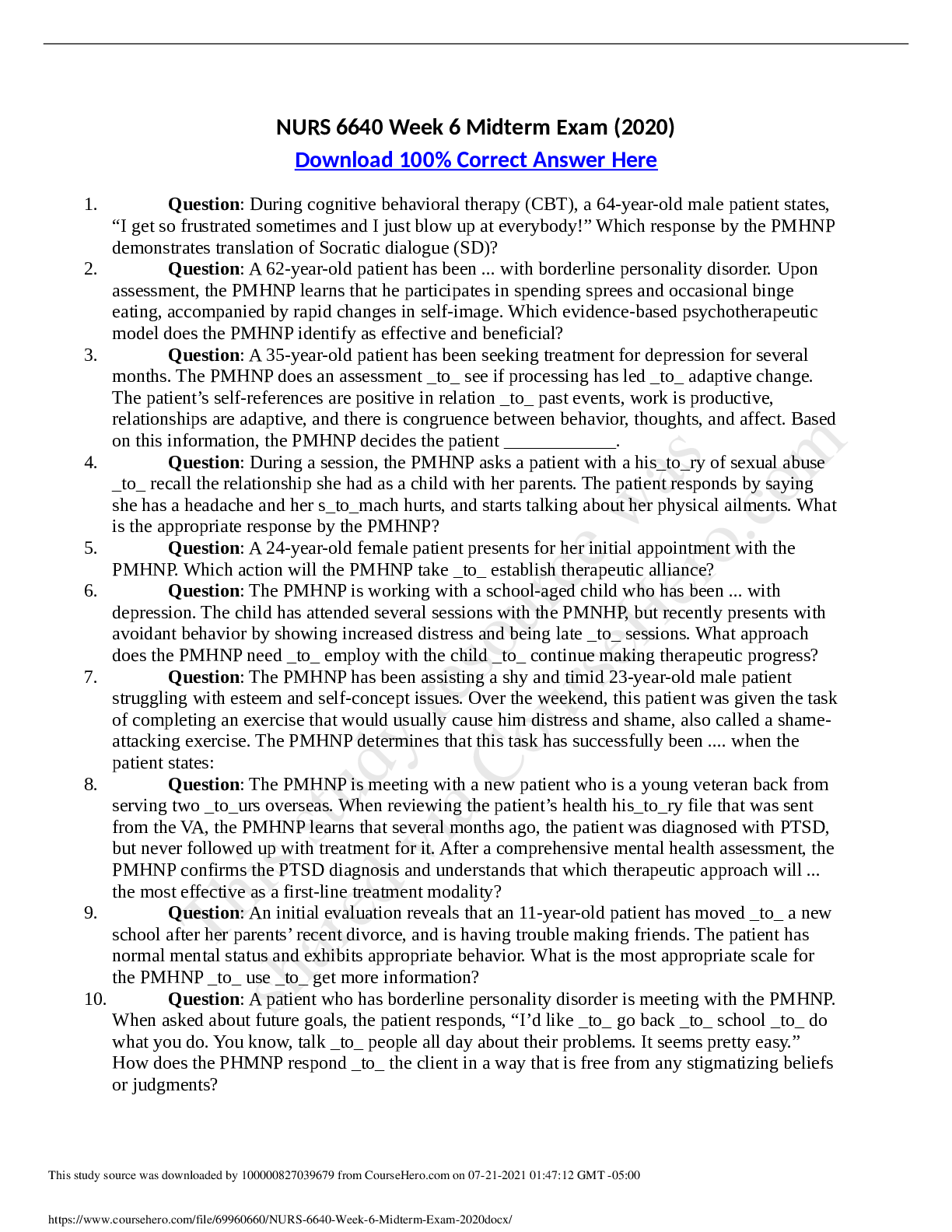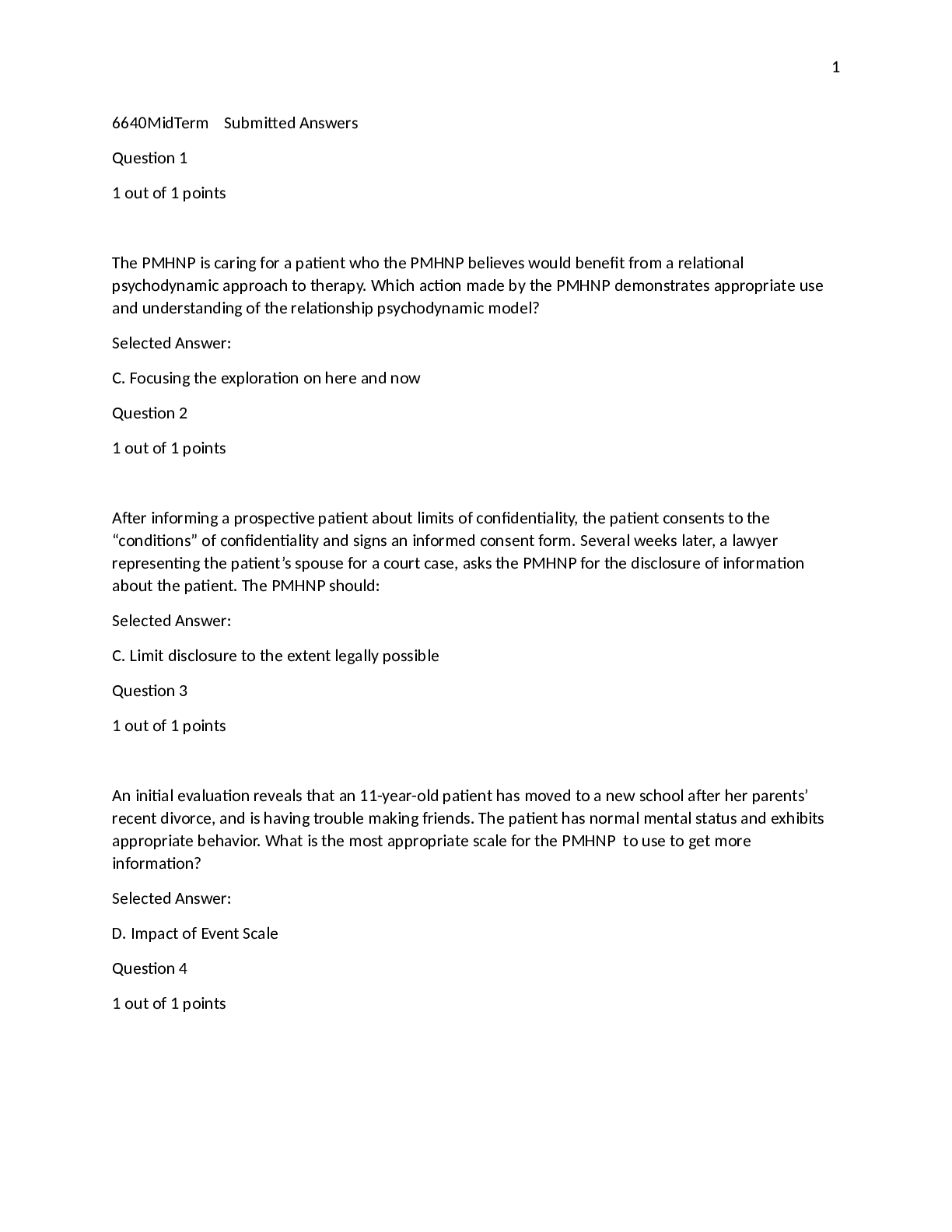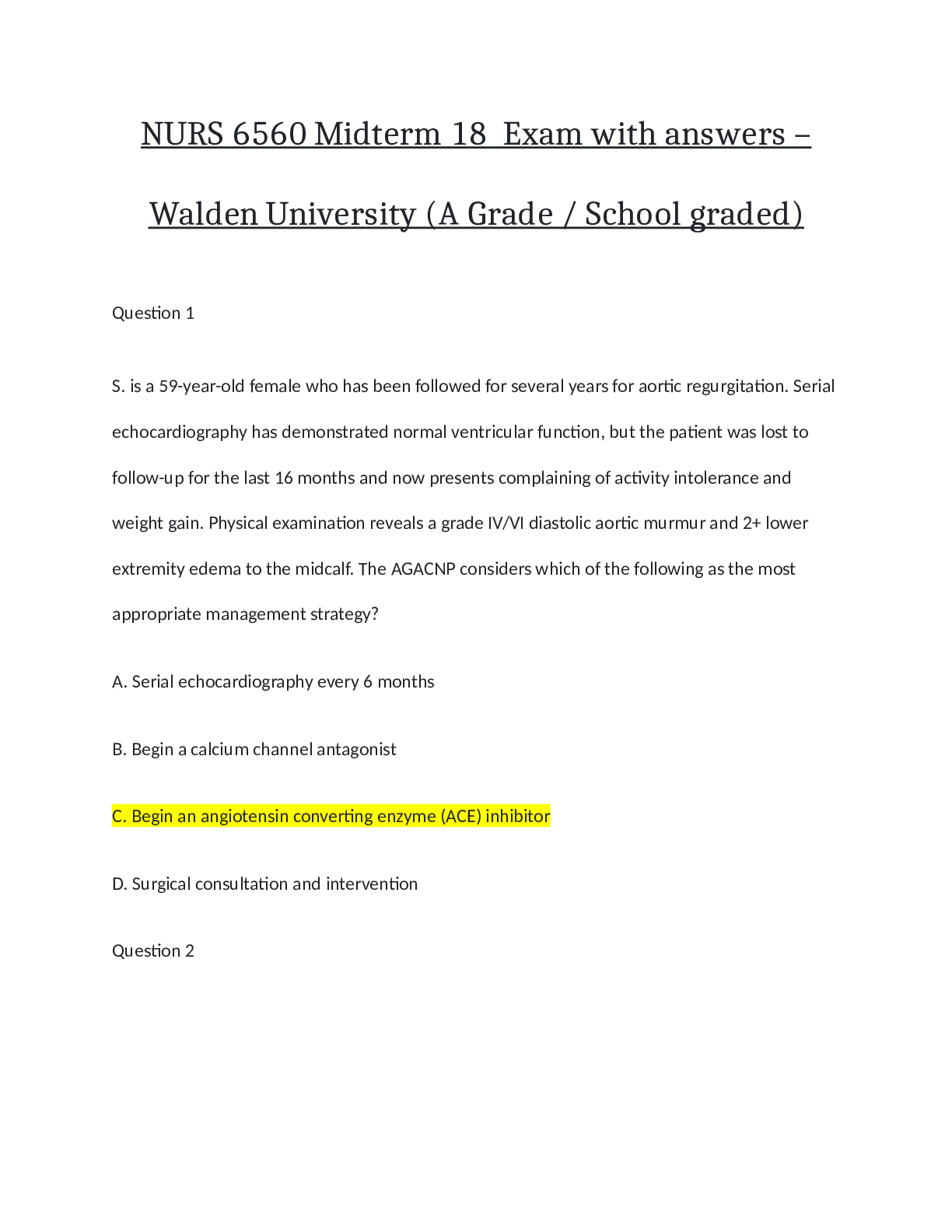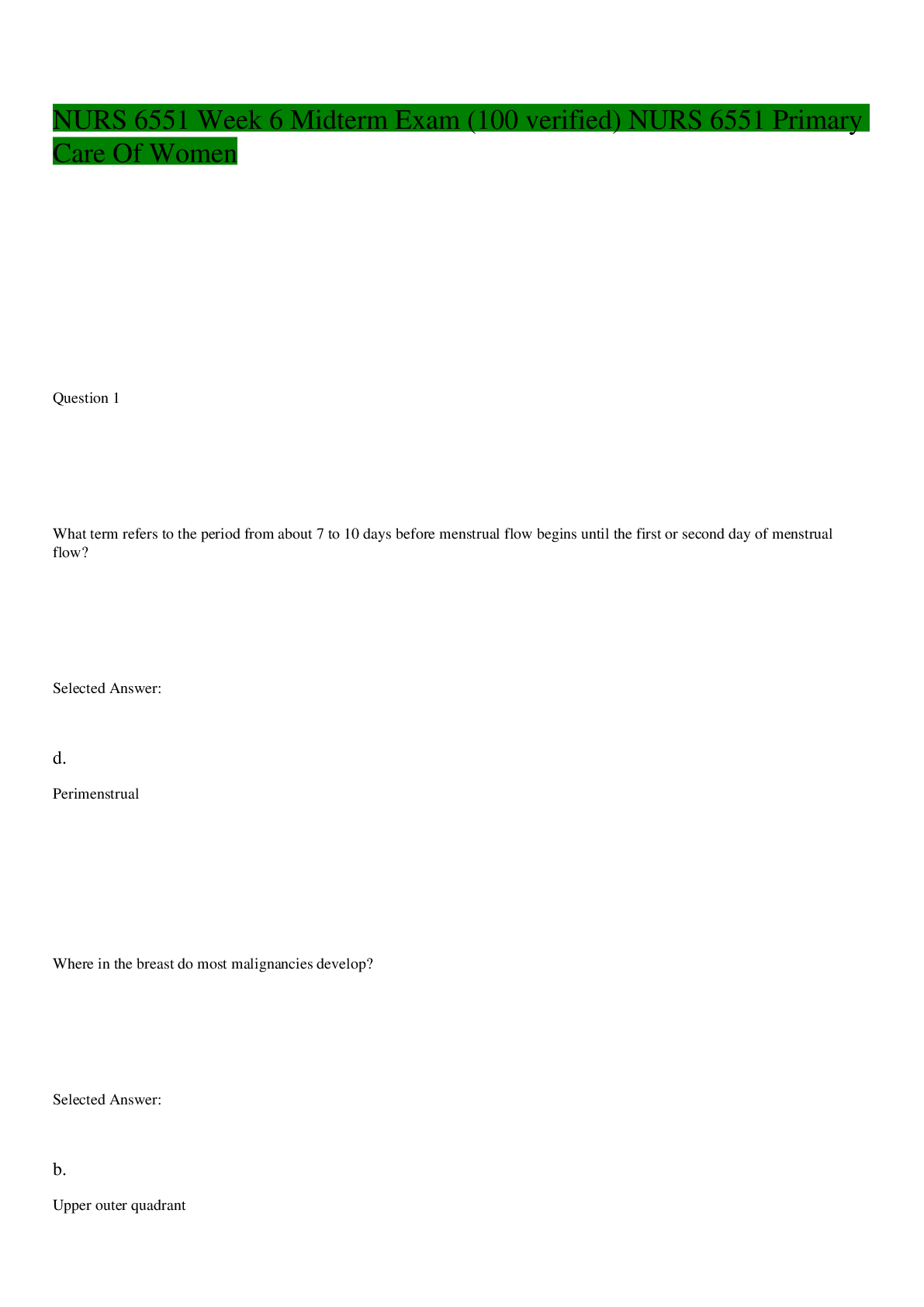*NURSING > QUESTIONS & ANSWERS > NURS 6640 WEEK 6 MIDTERM EXAM WITH VERIFIED ANSWERS (All)
NURS 6640 WEEK 6 MIDTERM EXAM WITH VERIFIED ANSWERS
Document Content and Description Below
• Question 1 1 out of 1 points An 11-year-old patient has been exhibiting low self-esteem at school and acting out. According to Maslow’s hierarchy of needs, which of the following questions... would best be addressed first by the PMHNP? • Question 2 1 out of 1 points The patient attempts the PMHNP’s sleep hygiene recommendations for 2 weeks, but does not make any progress mitigating nightmares and hyperarousal. Which behavioral strategy does the PMHNP suggest next? • Question 3 0 out of 1 points The PMHNP is caring for a patient who has acute stress disorder after experiencing a traumatic event 1 week prior. The PMHNP wants to begin with a therapeutic framework that follows the adaptive information processing (AIP) model. What is the priority action for the PMHNP to take? • Question 4 1 out of 1 points When the patient comes into the office, she says, “I just saw a friend of mine out in the waiting room. What’s wrong with him?” The PMHNP says, “He’ll be fine. He has mild depression.” Which of the following statement is correct related to confidentiality rights? • Question 5 1 out of 1 points The PMHNP has been assisting a shy and timid 23-year-old male patient struggling with esteem and self-concept issues. Over the weekend, this patient was given the task of completing an exercise that would usually cause him distress and shame, also called a shame-attacking exercise. The PMHNP determines that this task has successfully been achieved when the patient states: • Question 6 1 out of 1 points During a therapy session the patient is asked how she currently deals with stress, and she says, “Well, I don’t. I just let it build and build.” The PMHNP responds by asking how well this has been working out for her. The patient states, “Well, to be honest, it just feels like I’m drowning, you know what I mean.” Illustrating idiosyncratic meaning, the PMHNP responds with: • Question 7 1 out of 1 points During a clinical assessment of a 15-year-old patient, the PMHNP asks, “How can I help you?” The patient answers by saying, “Honestly, I don’t really think I need any help.” Which of the following is the most appropriate response by the PMHNP? • Question 8 1 out of 1 points During a therapy session with an 18-year-old female the PMHNP learns that she has lived in six different foster homes in the last 24 months. She states that her mother is in a correctional facility for drug abuse and prostitution. During the assessment, the PMHNP notices multiple superficial cuts to each wrist. The patient appears tearful, withdrawn, and never makes direct eye contact. The PMHNP believes that this patient may have feelings of insecurities as well as abandonment issues and is aware that which diagnosis is likely possible? • Question 9 1 out of 1 points The PMHNP is working with a school-aged child who has been diagnosed with depression. The child has attended several sessions with the PMNHP, but recently presents with avoidant behavior by showing increased distress and being late to sessions. What approach does the PMHNP need to employ with the child to continue making therapeutic progress? • Question 10 1 out of 1 points The PMHNP is working with a patient who experiences abreactions when discussing repressed feelings of his sexual abuse as a child. What can the PMHNP do to manage the patient’s intense emotional reactions? • Question 11 1 out of 1 points The PMHNP is working with a veteran who has posttraumatic stress disorder (PTSD). The PMHNP believes that dual awareness will be beneficial in allowing the patient to focus on the here and now. What strategies can the PMHNP use to develop dual awareness in the patient? • Question 12 1 out of 1 points A new patient has been informed of the limits of confidentiality, and has signed informed consent forms. No consent, however, has been obtained for voluntary “Release of Information.” The patient is 20 years old and still lives at home with his parents. He is being treated for depression, which he attributes to the trouble he’s had finding employment. True or false: If the patient’s mother calls the PMHNP to check up on her son to see how he is doing, the therapist is required to protect patient confidentiality and not disclose information. • Question 13 0 out of 1 points The PMHNP meets with a 47-year-old male patient who is fearful of leaving the house after having witnessed his neighbor getting run over by a car. When the PMHNP asks why he is afraid to leave his house, the patient replies, “Because another accident might occur.” Which cognitive behavioral therapy (CBT) strategy does the PMHNP employ? • Question 14 1 out of 1 points The PMHNP is treating a patient with a substantial fear of feeling closed in (claustrophobia). Thus, the patient will not get into an elevator. The office where he works is on the 10th floor and this requires that he walk up and down the stairs in the morning and evening to get to his office. With permission from the patient, the PMHNP is beginning systematic desensitization to address the patient’s need to use the elevator. What is the PMHNP’s best plan of action? • Question 15 1 out of 1 points The PMHNP is assessing a patient who grew up in a foster home because she was neglected and abused by her birth parents at a young age. The patient admits to having difficulty forming and maintaining relationships throughout her life. Understanding maladaptive schemas, which statement does the PMHNP predict that the patient is likely to make? • Question 16 1 out of 1 points When a PMHNP is seeing a patient for the first time, what is an important step to assure that the patient and provider understand the limits of their discussion? • Question 17 1 out of 1 points A PMHNP’s patients have already signed confidentiality agreements, including limits that will be imposed on confidentiality. Months later, the state’s laws have changed that affect confidentiality promises the PMHNP has already made. What is an appropriate step for the PMHNP to take after finding out this information? • Question 18 1 out of 1 points The PMHNP is caring for a patient with dissociated self-state that the PMHNP identifies as being associated with traumatic experiences in the patient’s past. What approach does the PMHNP use with the patient that is crucial to the psychodynamic therapy process? • Question 19 1 out of 1 points The PMHNP understands that anxiety and depression are two disorders in which their symptoms may overlap. When discussing this, you explain that the autonomic nervous system is activated and further helps distinguish anxiety symptoms by making the following points: • Question 20 0 out of 0 points When completing this exam, did you comply with Walden University’s Code of Conduct including the expectations for academic integrity? • Question 21 1 out of 1 points The PMHNP is working with a patient who has insomnia and battles going to sleep. The patient reports consistent self-defeating behaviors, and hates trying to go to sleep. Which action made by the PMHNP demonstrates the use of a paradoxical intervention? • Question 22 1 out of 1 points The PMHNP is meeting with a 38-year-old divorced, single mother who has been seeing the PMHNP for anxiety and anger management. During one of the sessions, the patient tells the PMHNP that she is having a problem getting her child support payments from her ex-husband, which is triggering increased anxiety and anger, which she admittedly takes out on her children. How does the PMHNP respond in a way that upholds the supportive psychodynamic psychotherapy approach? • Question 23 1 out of 1 points Your patient is a 65-year-old male who has a strained relationship with his son and daughter. His children refuse to participate in a family session. The PMHNP asks the patient to draw his family genogram as a next step to _______________. • Question 24 0 out of 1 points The PMHNP is working with a 43-year-old male patient who develops idiosyncratic transference over weeks of therapy. The best way for the PMHNP to respond to this patient is to ___________ : • Question 25 1 out of 1 points The PMHNP is working with a patient who is living in poverty and abusing substances. According to the treatment hierarchy framework, what needs does the PMHNP need to attend to first? • Question 26 1 out of 1 points A PMHNP is taking a history and wants to assess how the patient copes with adversity. To do so, the therapist asks questions about the patient’s belief system. What would be an appropriate question to ask? • Question 27 1 out of 1 points The PMHNP is meeting with a new patient who is a young veteran back from serving two tours overseas. When reviewing the patient’s health history file that was sent from the VA, the PMHNP learns that several months ago, the patient was diagnosed with PTSD, but never followed up with treatment for it. After a comprehensive mental health assessment, the PMHNP confirms the PTSD diagnosis and understands that which therapeutic approach will be the most effective as a first-line treatment modality? • Question 28 1 out of 1 points The PMHNP is mentoring a student. After working with a patient during a session, the student laments about all the things she should have, or could have, said to the patient. “I feel guilty that I didn’t speak up more about the patient’s concern toward her son,” says the student. The PMHNP understands that the student is exhibiting signs of which therapeutic concept? • Question 29 1 out of 1 points One of the strategies the PMHNP wants to try includes sleep restriction. What will the PMHNP suggest to follow sleep restriction therapy? • Question 30 0 out of 1 points A 24-year-old female patient presents for her initial appointment with the PMHNP. Which action will the PMHNP take to establish therapeutic alliance? • Question 31 1 out of 1 points The PMHNP employs psychodynamic psychotherapy with a patient who experiences anxiety and depression. As the process enters the psychoanalytic end of the psychodynamic continuum, the PMNHP will focus on: [Show More]
Last updated: 1 year ago
Preview 1 out of 19 pages
Instant download

Instant download
Reviews( 0 )
Document information
Connected school, study & course
About the document
Uploaded On
Jan 12, 2021
Number of pages
19
Written in
Additional information
This document has been written for:
Uploaded
Jan 12, 2021
Downloads
0
Views
56

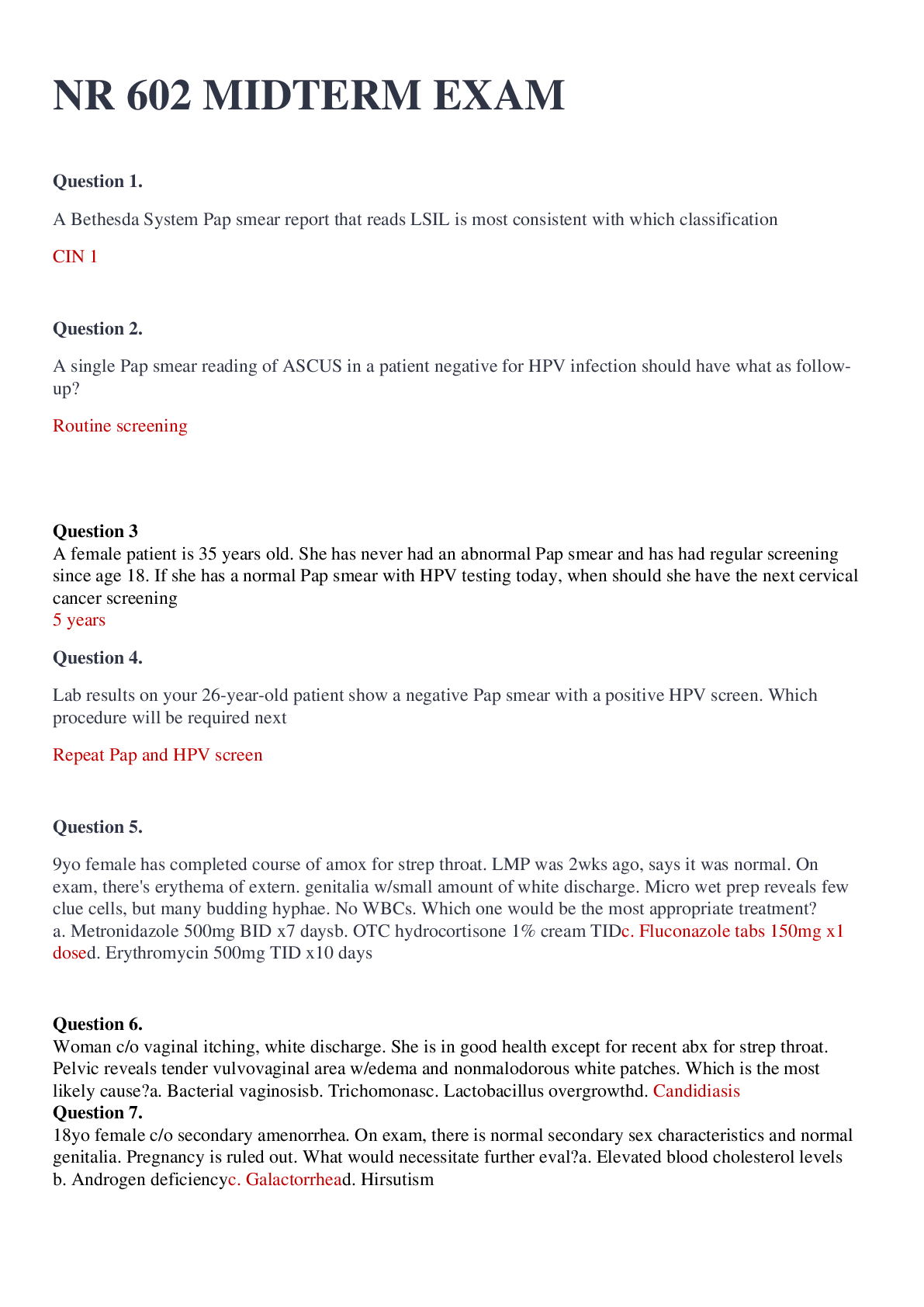
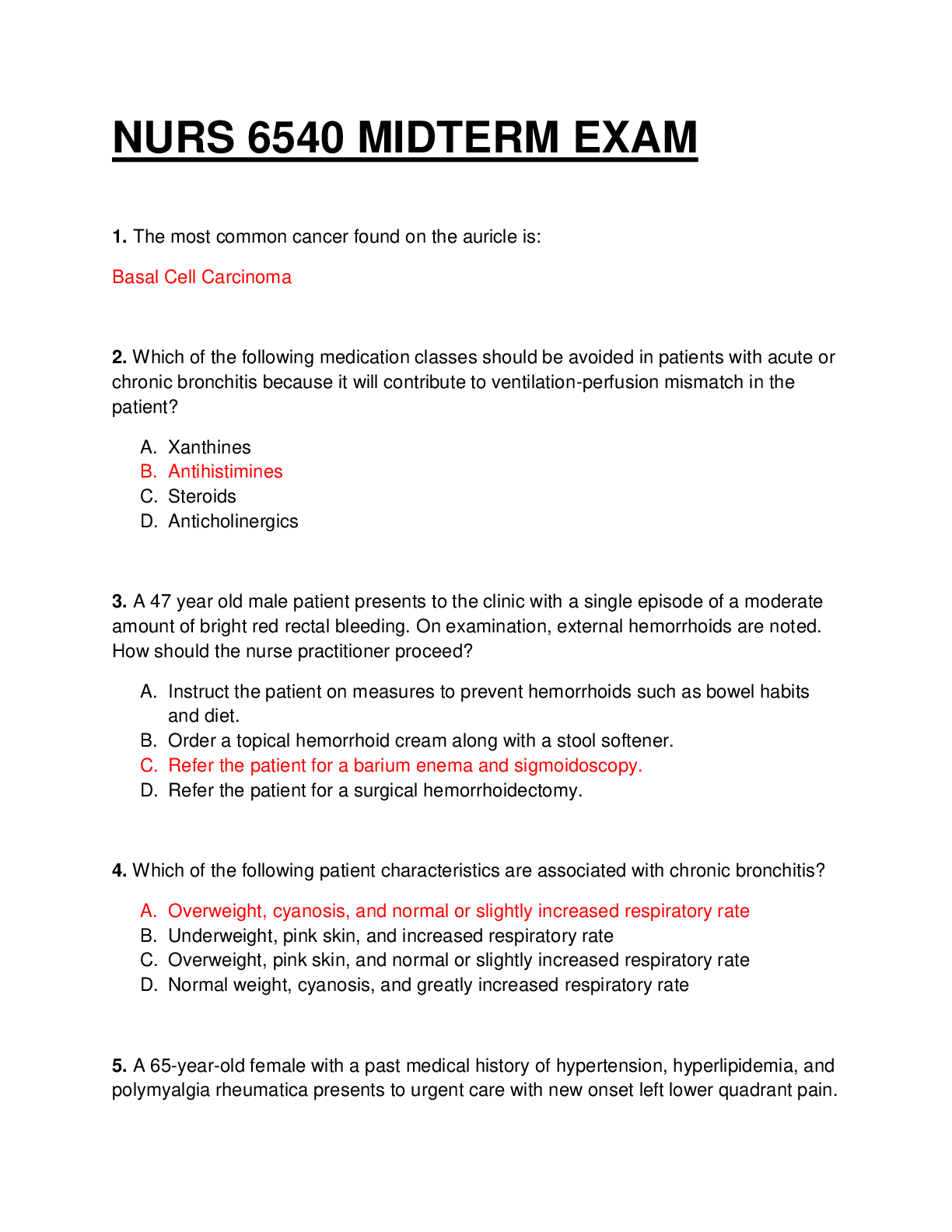
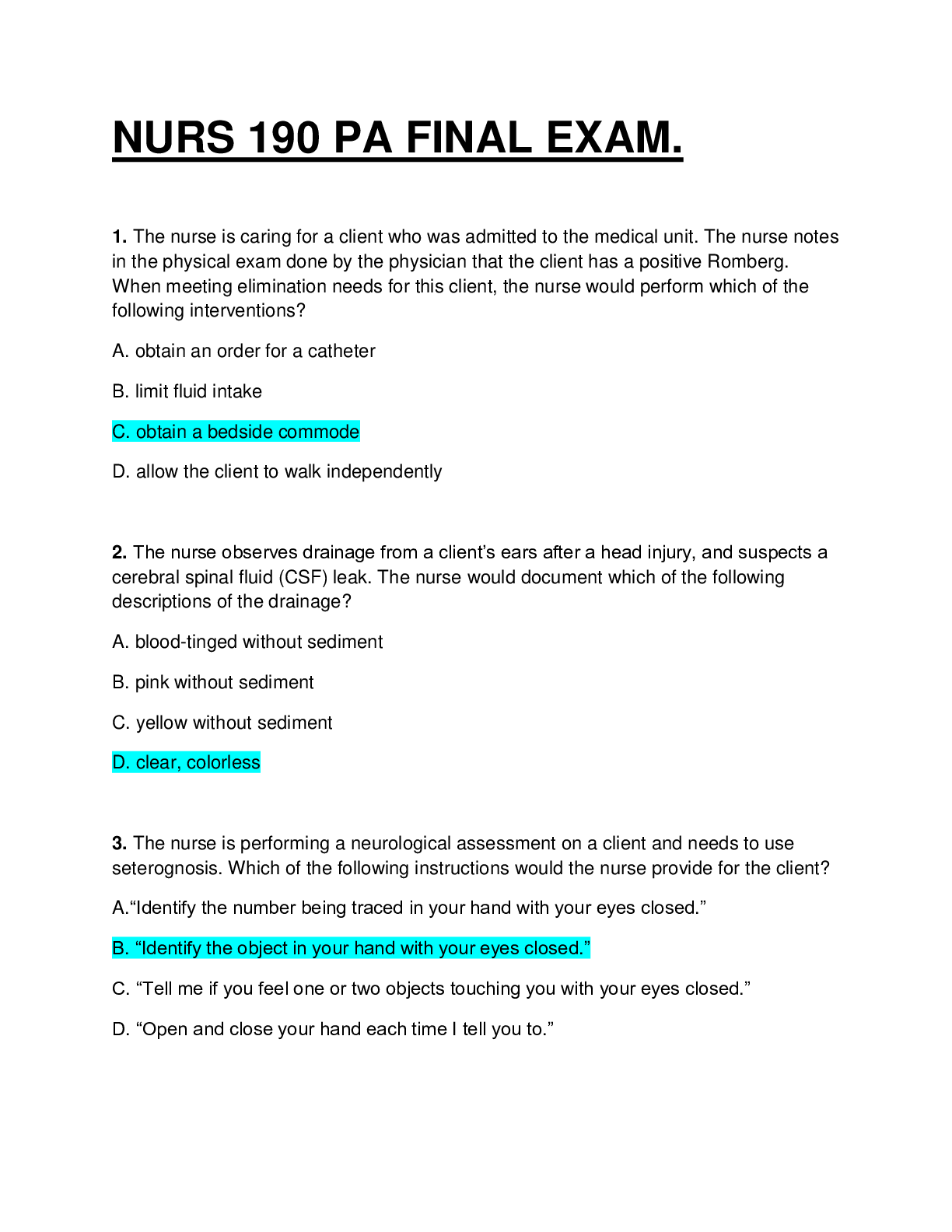
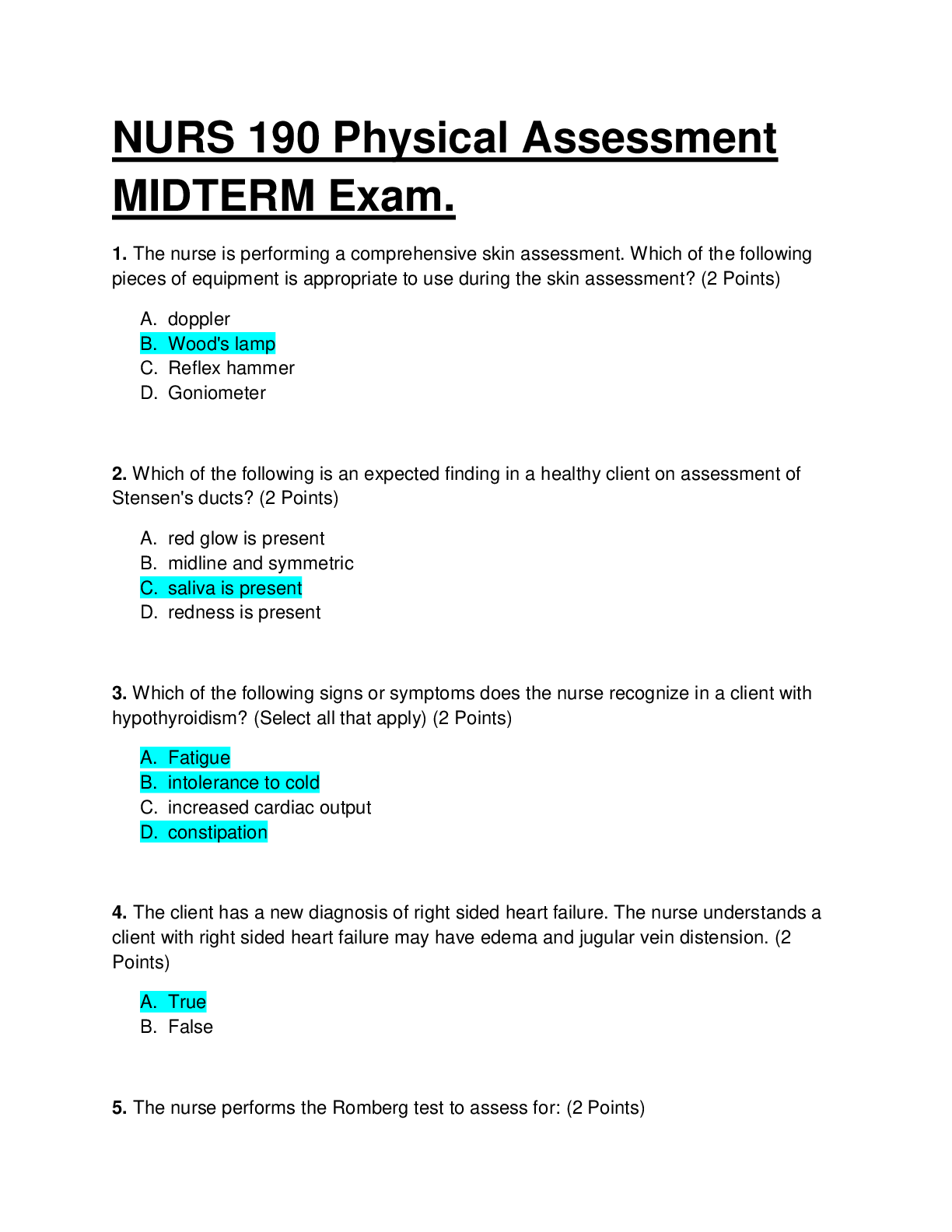
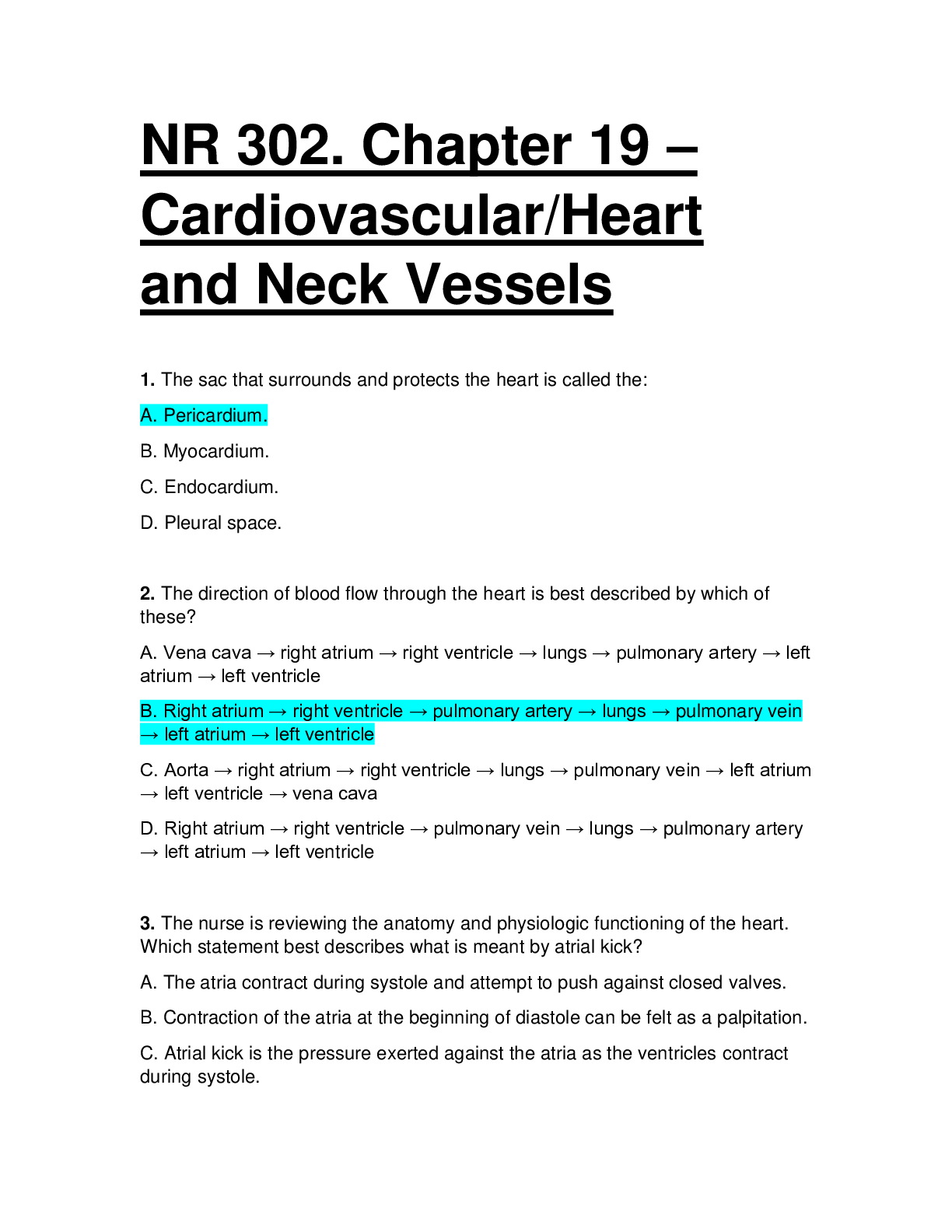
.png)
